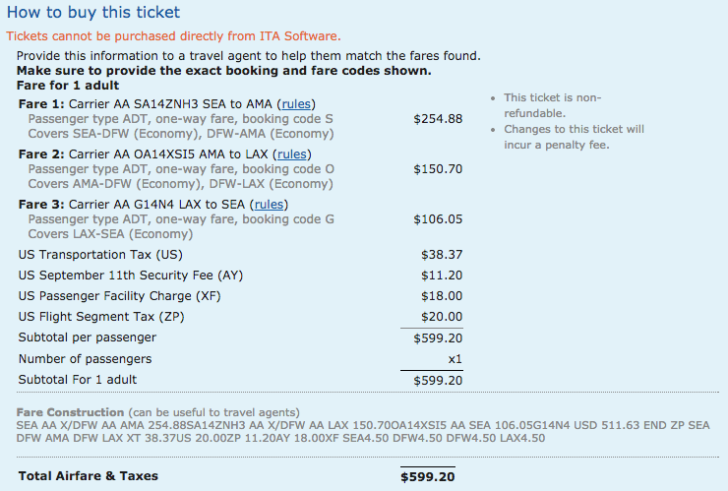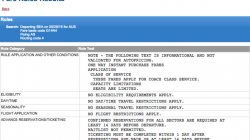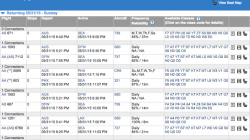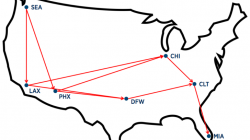In the last two days I’ve explained in detail how to search for fares and availability to construct an itinerary from Seattle to Austin. I plan to revisit these topics later to show how some rules might change for more complex international fares, but in general the same principles apply.
Other posts in this series:
- Introduction to ExpertFlyer: Fare Rules and Prices
- Introduction to ExpertFlyer: Finding Availability and Constructing Fares
- Introduction to ExpertFlyer: Benefits of Manual Fare Construction
- Introduction to ExpertFlyer: Combining Fares and Pricing Units
- Introduction to ExpertFlyer: Planning an Award Trip
- Introduction to ExpertFlyer: Routing Rules
The fare specifies a price with certain rules. To book that fare you must match it with availability on individual flights. Multiple fares can be combined in a single reservation as long as this is permitted by the rules of each fare. And at the end of this process — assuming you’re doing it as a consumer — you still can’t book the fare using ExpertFlyer. You’ll have to go to your usual travel search engine, the airline, or speak to a travel agent.
Why Bother with These Extra Steps?
As I explained in the introduction to my first post, understanding the actual availability and the published fares for a trip of interest provides you with the knowledge of what is and is not possible. Standard search engines just spit out some flights with a price. Why are you paying $1,000 for that ticket and not $200? Because Kayak told you so. Is there anything you can do to bring it down? Maybe… Enter new dates, and roll the dice again.
Most search engines provide you with no real understanding of what’s going on. Despite being convenient, I find opaque booking processes are more frustrating when I don’t get the results I like.
When you learn to construct your own fares, you can see exactly what’s on offer.
- The cheapest price is $220 on Frontier Airlines.
- To fly on my preferred carrier, Alaska Airlines, the cheapest price is $286.
- But availability to use that fare is limited. I can see at a glance which dates and flights can be used with lower fares and which will force me into higher fares.
Even if I never actually complete the process of constructing the fare, understanding how to find and read this information from ExpertFlyer could be useful, guiding my search on a more conventional online booking portal.
Warnings and Opportunities in the Fare Rules
Conventional search engines like Expedia might alert you to the fact that “only two tickets remain” at a certain price and you should book soon. This is because there are only two tickets left in that booking class, and when they are sold you will be offered a new booking class, requiring a different fare.
Knowing the actual availability in every bucket can help you plan for large groups or split ticket purchases into multiple reservations to obtain a lower average price. (All passengers on the same reservation must be ticketed in the same booking class, so limited availability will bump you up to a higher fare.)
Also, fare rules can warn you about time constraints on fares. An airline or online travel agency might say two tickets remain, but they almost never tell you that the fare expires tomorrow or has an advanced booking requirement. All the availability in the world won’t help you if the fare disappears.
A final opportunity comes in the form of stopovers, which let you visit multiple destinations on the same fare. I can understand why they aren’t advertised online. They’re often difficult to book online and may require calling an agent. But they can be a great way to maximize the value of paying $1,400 or more for an international ticket. The fare rules will tell you if you can book a stopover — sometimes for free but usually just $100-200.
Neither Humans nor Computers Catch Everything
In an earlier post on the challenges of using ITA Matrix to search for airfare, I focused on the importance of using advanced routing language to limit your search parameters. Computers have to search thousands or even millions of different fare combinations in order to identify the best result. This is because they don’t just search for fares between two cities. They also search for fares between connecting cities and run a check to see if combining multiple fares might be cheaper than booking a single fare.
I did something similar in yesterday’s post, where I combined two round-trip fares in different directions. But imagine a connecting flight from Seattle to New York that has four segments, stopping in Chicago each way:
- I could book a round-trip fare.
- I could book two one-way fares between Seattle and New York.
- I could book four one-way fares between (1/4) Seattle-Chicago and (2/3) Chicago-New York.
- I could book three one-way fares, using one fare to cover the entire outbound journey and two fares to cover the return segments separately.
Each of these scenarios could be booked using a single reservation as long as the fare rules permitted combinations with other fares. Unfortunately this complexity adds up quickly, and ExpertFlyer isn’t searching for fares to your connecting airports. You’ll only see fares between your origin and destination unless you perform another search.
In an example that I presented at Frequent Traveler University, I found what I thought was a cheap fare from Seattle to Amarillo, TX, connecting in Dallas. When I used ITA to confirm the price of my itinerary, it showed me I could save about $50 purchasing three separate fares, one fare from Seattle to Amarillo on the outbound while using two separate fares on the return to get from Amarillo to LAX and from LAX to Seattle. That’s almost 8% savings.
The average consumer never sees the mix of fares that go into pricing their final itinerary, and they usually don’t care. I thought by doing it myself I could be smarter than most people. 😉 Fortunately the computer prevented me from making a big mistake.
Computers make their own mistakes, however. Many search queries are limited to a maximum duration and cannot explore all the millions of possible itineraries. They use some good strategy to make sure they cover what are likely to be the best ones, but there’s no guarantee.
Anyone who has booked award tickets regularly has probably had experience with search tools or agents who try to deduct too many miles or charge too many fees. The same thing happens with regular tickets. Knowing what you ought to pay can prevent you from getting swindled, even if it’s an accident. That’s why I prefer to use both methods to check each other.
Summary
Today’s post was about the advantages and disadvantages of devoting more effort to manual fare construction. I don’t think I shared much new information about how you can actually go about the process. However, I’ll expand tomorrow on the complex nature of fare combinations, which directly relates to the information you’ll find in fare rules and can be useful for creating complex itineraries.





